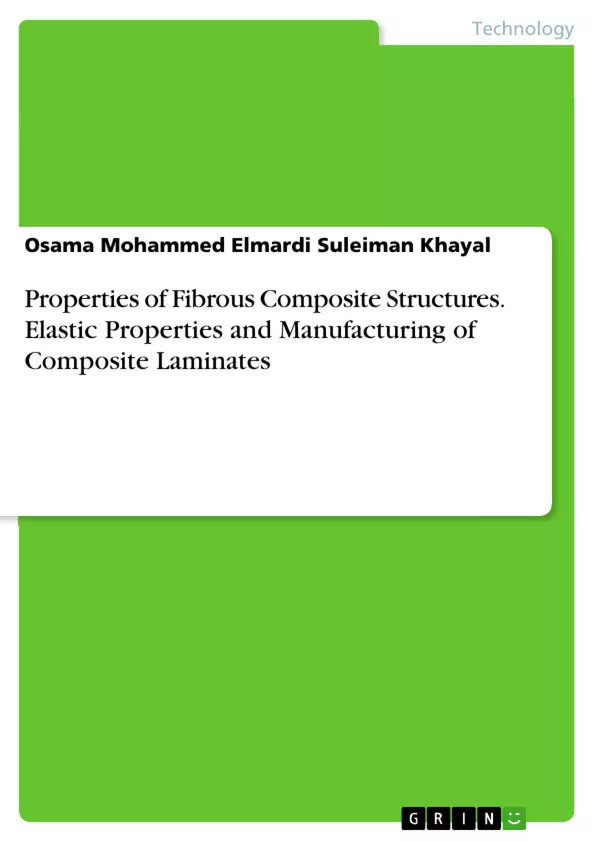The present text book comprises four chapters. Chapter one in this book includes an introduction to composite materials. The different topics in this chapter are discussed from the viewpoints of general introduction; historical background; composite materials; products of composite materials; overview of composite materials; cores in composites; and semi crystalline polymers.
In chapter two, manufacturing and fabrication of composites is presented and discussed thoroughly from the consideration of methods of fabrication; overview of mold; other fabrication methods; and tooling.
Chapter three deliberates the elastic properties of composites from the considerations of introduction; structure of composites; mechanical properties of a fiber reinforced lamina which includes stiffness and strength of a lamina, and analytical modeling of composite laminates.
In chapter four, the most important findings and conclusions are presented and discussed. The textbook is suitable as a textbook for a first course as an introduction to fibrous composite laminated structures from the consideration of their elastic properties and fabrication. It can be used as a reference by engineers and scientists working in industry and academic institutions.
Inhaltsverzeichnis (Table of Contents)
- Introduction to Composite Materials
- Manufacturing and Fabrication of Composites
- Elastic Properties of Composites
Zielsetzung und Themenschwerpunkte (Objectives and Key Themes)
This textbook aims to provide undergraduate and postgraduate engineering students with a foundational understanding of the elastic properties and manufacturing processes of composite laminates. It explores the advantages of composite materials, delves into various fabrication techniques, and analyzes the mechanical properties of these materials using a micromechanical approach.
- Introduction to composite materials and their properties
- Manufacturing and fabrication techniques for composites
- Elastic properties of composite laminates, including stiffness and strength
- Micromechanical analysis of composite materials
- Applications of composite materials in engineering
Zusammenfassung der Kapitel (Chapter Summaries)
Introduction to Composite Materials: This chapter introduces the fundamental concepts of composite materials, including their definition, advantages over traditional materials, and the roles of reinforcement and matrix components. It provides a historical overview of composite material development and explores various types of composite materials, outlining their properties and applications. The chapter also delves into the concept of cores in composites and discusses semi-crystalline polymers, emphasizing their significance in the overall structure and performance of these materials. The discussion establishes the groundwork for understanding the subsequent chapters on manufacturing and elastic properties.
Manufacturing and Fabrication of Composites: This chapter thoroughly explores the diverse manufacturing and fabrication methods used to create composite materials. It begins with an overview of general fabrication techniques, emphasizing the importance of wetting, mixing, or saturating the reinforcement with the matrix. Various methods are detailed, such as advanced fiber placement, filament winding, and pultrusion molding, highlighting their respective strengths and weaknesses. The chapter also covers the crucial role of tooling and mold design in the overall fabrication process, providing a comprehensive overview of the practical aspects of composite material production. The descriptions provided are designed to equip readers with a practical understanding of the industry.
Elastic Properties of Composites: This chapter focuses on the elastic properties of composite materials. It begins with an overview of the structure of composites, linking this structure directly to their mechanical properties. A significant portion is dedicated to the stiffness and strength of a fiber-reinforced lamina, a crucial aspect for engineering applications. The chapter then introduces the analytical modeling of composite laminates, utilizing a micromechanical approach to analyze the volume proportions of constituents and their influence on the overall lamina's stiffness and strength. This section provides the theoretical framework necessary to understand and predict the behavior of composite materials under stress.
Schlüsselwörter (Keywords)
Fiber, composite laminates, micromechanical approach, stiffness and strength, manufacturing and fabrication, composite materials, elastic properties, reinforcement, matrix.
FAQ: Comprehensive Language Preview of Composite Materials
What is the purpose of this textbook?
This textbook aims to provide undergraduate and postgraduate engineering students with a foundational understanding of the elastic properties and manufacturing processes of composite laminates. It explores the advantages of composite materials, delves into various fabrication techniques, and analyzes the mechanical properties of these materials using a micromechanical approach.
What topics are covered in the textbook?
The textbook covers the following key themes: introduction to composite materials and their properties; manufacturing and fabrication techniques for composites; elastic properties of composite laminates, including stiffness and strength; micromechanical analysis of composite materials; and applications of composite materials in engineering.
What are the key themes explored in the "Introduction to Composite Materials" chapter?
This chapter introduces fundamental concepts of composite materials, including their definition, advantages, roles of reinforcement and matrix components, a historical overview, various types, properties, applications, the concept of cores, and semi-crystalline polymers.
What does the "Manufacturing and Fabrication of Composites" chapter cover?
This chapter explores diverse manufacturing and fabrication methods for composite materials. It covers general fabrication techniques, advanced fiber placement, filament winding, pultrusion molding, and the role of tooling and mold design.
What is the focus of the "Elastic Properties of Composites" chapter?
This chapter focuses on the elastic properties of composite materials, the structure of composites and their mechanical properties, the stiffness and strength of fiber-reinforced lamina, and analytical modeling of composite laminates using a micromechanical approach.
What are the key terms associated with this textbook?
Key terms include: fiber, composite laminates, micromechanical approach, stiffness and strength, manufacturing and fabrication, composite materials, elastic properties, reinforcement, and matrix.
What is the structure of the textbook preview?
The preview includes a table of contents, objectives and key themes, chapter summaries, and keywords.
Who is the intended audience for this textbook?
The intended audience is undergraduate and postgraduate engineering students.
What approach is used to analyze the mechanical properties of composite materials?
A micromechanical approach is used to analyze the mechanical properties.
What are some examples of manufacturing and fabrication techniques discussed?
Examples include advanced fiber placement, filament winding, and pultrusion molding.
- Quote paper
- Osama Mohammed Elmardi Suleiman Khayal (Author), 2022, Properties of Fibrous Composite Structures. Elastic Properties and Manufacturing of Composite Laminates, Munich, GRIN Verlag, https://www.grin.com/document/1298479



